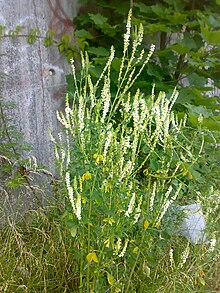4-hydroxycoumarins
4-Hydroxycoumarins ( vitamin K antagonists , also abbreviated as coumarins or coumarin derivatives ) are known in medicine as substances derived from 4-hydroxycoumarin with anti-clotting effects. Their effect is based on an inhibition of the vitamin K metabolism, which is important for the formation of blood coagulation factors. In medicine, coumarins are used as anticoagulant drugs ( anticoagulants ). In addition, coumarins are also used as rodenticides, particularly for combating rats .
history
The scientific development of coumarins began with the discovery of dicoumarol in sweet clover -containing hay by Karl Paul Link and employees in 1940. The formation of dicoumarol in hay and silage from the information contained coumarin-containing pasture plants may be at a faulty manufacturing or storage fungi. The feeding of feed containing dicoumarol can lead to internal bleeding in grazing cattle due to the inhibition of blood coagulation ( sweet clover disease ). Based on this knowledge, this new substance was first clinically tested as an anticoagulant in 1941.
In the 1940s, derivatives of dicoumarol were developed in particular by the working group of Karl P. Link. While Link thought these substances were too toxic and therefore not marketable, his colleague Mark A. Stahmann believed they could be used and, with the help of the Wisconsin Alumni Research Foundation (WARF), applied for a patent for the substance warfarin named after it . In 1948 warfarin was first launched as a rodenticide. After a member of the US Navy tried unsuccessfully to kill himself with warfarin in 1951 and was saved thanks to the administration of vitamin K as an antidote , the therapeutic potential of warfarin, now considered safe, was also investigated. In 1954, warfarin was approved for medical use. The coumarins Tromexan and Phenprocoumon were introduced as anticoagulants shortly before . The anticoagulants of the dicoumarol type became famous in 1955 when the then President of the United States Dwight D. Eisenhower was treated with them after a heart attack .
chemistry
The coumarins used in medicine and pest control are structurally derived from the 4-position hydroxylated coumarin .




Acenocoumarol
(anticoagulant)Coumatetralyl
(rodenticide)Brodifacoum
(rodenticide)Bromadiolone
(rodenticide)
effect
When used as a drug and as a rodenticide , the following effects of the coumarins are used:
The factors of plasmatic blood coagulation have to be modified in the liver : The amino acid glutamate is carboxylated on the γ-C atom so that the factors bind to the platelet surface using calcium ions and thus can develop their maximum effect. The reaction is catalyzed by γ-glutamyl carboxylase and requires vitamin K in its biologically active form - vitamin K hydroquinone - as a cosubstrate .
The vitamin K hydroquinone emerges from the reaction as vitamin K epoxide. In order to be available for further carboxylation, the vitamin K epoxide is reduced to vitamin K hydroquinone by the enzyme vitamin K oxidoreductase via the intermediate vitamin K quinone. Coumarins have a structural similarity to vitamin K and inhibit both partial reactions competitively . Coumarin derivatives reduce the formation of coagulation factors by inhibiting the regeneration of vitamin K in its biologically active form. The effect only occurs after the coagulation factors that were circulating in the blood at the time the coumarin derivative was administered have been partially used up. This is only the case after about six hours. The maximum effect is reached after 36-48 hours.
Therapy monitoring
Until now, the effect has often been checked using the Quick value . Since the Quick-values of various laboratories / reagents differ, is to improve comparability increased INR ( English international normalized ratio ) indicated. In order to avoid serious side effects , in addition to reliably taking the medication, regular monitoring of this value is necessary. In the chronically ill, this can also be done at home with the help of portable test devices as part of coagulation self-management, which can mean an increased quality of life for those affected (closer controls, greater mobility).
Patients who are administered phenprocoumon receive a “passport” to carry with them so that the restricted coagulation situation can be identified in an emergency, even if the patient cannot be approached. The current Quick value or INR value must be entered in such a passport after each blood test; The currently prescribed dosage should also always be up to date. A target quick or target INR to which the patient is set is also noted in this passport.
indication
Therapy with coumarins is necessary in patients who are at high risk of developing a thrombosis . This can be the case, for example:
- after implantation of artificial heart valves ,
- after a thrombosis that has already occurred to prevent recurrence,
- with atrial fibrillation ,
- for heart diseases with an enlarged heart chamber and poor pump function ,
- after implantation of artificial vascular prostheses,
- after a heart attack .
Side effects and restrictions on use
The side effects of coumarins result from their main effect. Since coumarin therapy reduces blood clotting, bleeding increases. This can be expressed, for example, in:
- increased tendency to bruise,
- increased bleeding gums,
- Bleeding in the gastrointestinal tract,
- Bleeding through the skin,
- Blood in the urine,
- Strokes from cerebral haemorrhage .
If you are pregnant, the use of coumarins is contraindicated because of their teratogenic effects .
Regional anesthesia procedures close to the spinal cord ( spinal anesthesia or epidural anesthesia ) should only be carried out if the INR, as a measure of the blood clotting time, has fallen below 1.4 after discontinuation of the coumarin administration.
Interactions
Coumarins show a strong plasma protein binding . If substances are taken which in turn have a higher plasma protein binding capacity than coumarins, there is a sudden release of the bound coumarins with a marked increase in effectiveness. In the past, this could be observed in particular with the simultaneous administration of first-generation sulfonylureas (e.g. tolbutamide ) and warfarin or phenprocoumon . Newer sulfonylureas no longer show this interaction.
Coumarins are mainly broken down in the liver via cytochrome P450 3A4 and cytochrome P450 2C9 . Inhibitors of these enzyme systems lead to a slower breakdown of coumarins and to an accumulation after repeated ingestion, combined with an increased risk of bleeding. This risk exists not only when coumarins are taken at the same time as drugs that inhibit CYP-3A4 or CYP-2C9, but also with some foods. The Federal Institute for Drugs and Medical Devices (BfArM) warned patients who take coumarins of possible bleeding complications due to increased coumarin plasma levels due to CYP-C29 inhibition after consuming Chinese wolfberries (common wolfberry ).
Combination with platelet aggregation inhibitors such as acetylsalicylic acid also increases the risk of bleeding. Furthermore, the risk of bleeding increases with simultaneous use of cephalosporins , but also SNRI and SSRI . Both of the latter also have an inhibitory effect on platelet aggregation due to the depletion of serotonin in the blood platelets.
preparations
Well-known coumarins are:
- Phenprocoumon (product names Marcumar, Falithrom )
- Warfarin (product names Coumadin , Marevan )
- Acenocumarol (product name Sintrom )
Antidote
In the event of poisoning with coumarins, high-dose vitamin K must be given immediately as an antidote to compensate for the lack of vitamin K regeneration. Here, too, there is a delay in the effect, since the missing coagulation factors can only be gradually replaced by the liver. Long-term therapy with vitamin K is necessary, especially in the case of poisoning by Brodifacoum , Difenacoum , Bromadiolon , Difethialon or Flocoumafen ( rodenticides ). In an emergency, the missing coagulation factors can be replaced directly.
Individual evidence
- ↑ Pschyrembel: Clinical Dictionary , Volume 258. de Gruyter, 1998, ISBN 3110148242 , p. 312.
- ↑ Stahmann MA, Huebner CF, Link KP: Studies on the hemorrhagic sweet clover disease; identification and synthesis of the hemorrhagic agent . In: J. Biol. Chem. . 138, No. 2, 1941, pp. 513-527.
- ↑ A. Bye, HK King: The biosynthesis of 4-hydroxycoumarin and dicoumarol by Aspergillus fumigatus Fresenius . In: Biochemical Journal . 117, 1970, pp. 237-245.
- ^ A b Nicole Kresge, Robert D. Simoni, Robert L. Hill: Hemorrhagic Sweet Clover Disease, Dicumarol, and Warfarin: the Work of Karl Paul Link . In: J. Biol. Chem. . 280, 2005, p. E5.
- ↑ Link KP: The Discovery of Dicumarol and Its Sequels . In: Circulation . 19, 1959, pp. 97-107. doi : 10.1161 / 01.CIR.19.1.97 .
- ↑ Wiebke Gogarten, Hugo Van Aken: Perioperative thrombosis prophylaxis - platelet aggregation inhibitors - importance for anesthesia In: AINS - anesthesiology · intensive care medicine · emergency medicine · pain therapy. 47, 2012, pp. 242-252, doi : 10.1055 / s-0032-1310414 .
- ↑ SA Kozek-Langenecker, D. Fries, M. Gütl, N. Hofmann, P. Innerhofer, W. Kneifl, L. Neuner, P. Perger, T. Pernerstorfer, G. Pfanner, et al .: Locoregional anesthesia under anticoagulant medication. Recommendations of the Perioperative Coagulation Working Group (AGPG) of the Austrian Society for Anaesthesiology and Intensive Care Medicine (ÖGARI). DER ANESTHESIST Volume 54, Number 5 (2005), 476–484, doi : 10.1007 / s00101-005-0827-0
- ↑ Flügge I: Possible interaction between vitamin K antagonists and the goji berry - risk of INR increase and severe bleeding events. Archived from the original on December 5, 2013. In: Bulletin for drug safety . No. 1, 2013. Retrieved April 6, 2013.
- ^ P. Schweikert-Wehner: DOAK update interactions . Ed .: Pharmaceutical newspaper. tape 162 , no. 38 . Govi Verlag, Eschborn September 20, 2017, p. 92 .





